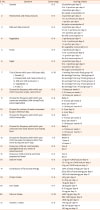1. Golley R, Baines E, Bassett P, Wood L, Pearce J, Nelson M. School lunch and learning behaviour in primary schools: an intervention study. Eur J Clin Nutr. 2010; 64:1280–1288.

2. Cockroft JE, Durkin M, Masding C, Cade JE. Fruit and vegetable intakes in a sample of pre-school children participating in the ‘Five for All’ project in Bradford. Public Health Nutr. 2005; 8:861–869.

3. Forastiere F, Pistelli R, Sestini P, Fortes C, Renzoni E, Rusconi F, et al. Consumption of fresh fruit rich in vitamin C and wheezing symptoms in children. SIDRIA Collaborative Group, Italy (Italian Studies on Respiratory Disorders in Children and the Environment). Thorax. 2000; 55:283–288.

4. Simon A, O'Connell R, Stephen AM. Designing a nutritional scoring system for assessing diet quality for children aged 10 years an under in the UK. Method Innov Online. 2012; 7:27–47.
5. Indian Council of Medical Research. Nutrient requirements and recommended dietary allowances for Indians: a report of the Expert Group of the Indian Council of Medical Research. New Delhi: Indian Council of Medical Research;2010. vi-255.
6. Indian Council of Medical Research. National ethical guidelines for biomedical and health research involving human participants. New Delhi: Indian Council of Medical Research;2017. ix-170.
7. Gururaj , Maheshwaran . Kuppuswamy's socio-economic status scale - a revision of income parameter for 2014. International Journal of Recent Trends in Science And Technology. 2014; 11:1–2.
8. Longvah T, Ananthan I, Bhaskarachary K, Venkaiah K. National Institute of Nutrition. (India). Indian food composition tables. Hyderabad: National Institute of Nutrition;2017. xxxi-536.
9. Kim S, Haines PS, Siega-Riz AM, Popkin BM. The Diet Quality Index-International (DQI-I) provides an effective tool for cross-national comparison of diet quality as illustrated by China and the United States. J Nutr. 2003; 133:3476–3484.

10. Bora P, Kulshreshtha K. Assessment of nutritional status of school going children in the age group 7-9 Years. Asian J Home Sci. 2016; 11:238–245.

11. Sharma G, Lakhawat S. Nutritional intervention study - nutritional status of rural school going children and maternal nutritional knowledge. Int Res J Social Sci. 2017; 6:10–16.
12. Polit DF, Beck CT. Nursing research: principles and methods. 7th ed. Philadelphia: Lippincott Williams & Wilkins;2004.
13. Tuckman BW. Conducting educational research. 5th ed. Orlando: Harcourt Brace College Publishers;1999. viii-277.
14. Lawshe CH. A quantitative approach to content validity. Pers Psychol. 1975; 28:563–575.

15. Allahyari T, Rangi NH, Khosravi Y, Zayeri F. Development and evaluation of a new questionnaire for rating of cognitive failures at work. Int J Occup Hyg. 2011; 3:6–11.
16. Parsian N, Trisha Dunning AM. Developing and validating a questionnaire to measure spirituality: a psychometric process. Glob J Health Sci. 2009; 1:2–11.

17. Timlin MT, Pereira MA, Story M, Neumark-Sztainer D. Breakfast eating and weight change in a 5-year prospective analysis of adolescents: project EAT (Eating Among Teens). Pediatrics. 2008; 121:e638–45.

18. Tin SP, Ho SY, Mak KH, Wan KL, Lam TH. Lifestyle and socioeconomic correlates of breakfast skipping in Hong Kong primary 4 schoolchildren. Prev Med. 2011; 52:250–253.

19. Chitra U, Reddy CR. The role of breakfast in nutrient intake of urban schoolchildren. Public Health Nutr. 2007; 10:55–58.

20. Garg M, Rajesh V, Kumar P. Effect of breakfast skipping on nutritional status and school performance of 10-16 years old children of Udupi district. Health Popul - Perspec Issues. 2014; 37:98–117.
21. Deshmukh-Taskar PR, Nicklas TA, O'Neil CE, Keast DR, Radcliffe JD, Cho S. The relationship of breakfast skipping and type of breakfast consumption with nutrient intake and weight status in children and adolescents: the National Health and Nutrition Examination Survey 1999-2006. J Am Diet Assoc. 2010; 110:869–878.

22. Adolphus K, Lawton CL, Dye L. The effects of breakfast on behavior and academic performance in children and adolescents. Front Hum Neurosci. 2013; 7:425.

23. Rana N. Effects of advertisements on children with specialreference to confectionary products in India. Int J New Technol Res. 2015; 1:1–4.
24. Verma A, Sonkar S. Assessment of nutritional status of selected school female children age between 7-9 years of lower-income group of two block of lucknow. Int J Sci Eng Res. 2013; 4:1479–1483.
25. Sati V, Dahiya S. Nutritional assessment of rural school-going children (7-9 years) of hisar district, Haryana. Open Access Sci Rep. 2012; 1:1–4.
26. Singh S, Srivastava S. Nutrient intake and food adequacy of the school going children of Allahabad district. IMPACT: IJRANSS. 2016; 4:25–30.
27. Soni RP, Katoch M. Dietary adequacy of school going children in selected areas of Himachal Pradesh. IOSR J Humanit Soc Sci. 2014; 19:85–90.

28. Wang P, Chen C, Yang R, Wu Y. Psychometric evaluation of health related quality of life among rural-to-urban migrants in China. Health Qual Life Outcomes. 2015; 13:155.

29. Guilford JP. Fundamental statistics in psychology and education. New York: McGraw-Hill Book Company;1956. p. 565.
30. Tavakol M, Dennick R. Making sense of Cronbach's alpha. Int J Med Educ. 2011; 2:53–55.

31. Guenther PM, Kirkpatrick SI, Reedy J, Krebs-Smith SM, Buckman DW, Dodd KW, et al. The Healthy Eating Index-2010 is a valid and reliable measure of diet quality according to the 2010 Dietary Guidelines For Americans. J Nutr. 2014; 144:399–407.










 PDF
PDF ePub
ePub Citation
Citation Print
Print




 XML Download
XML Download